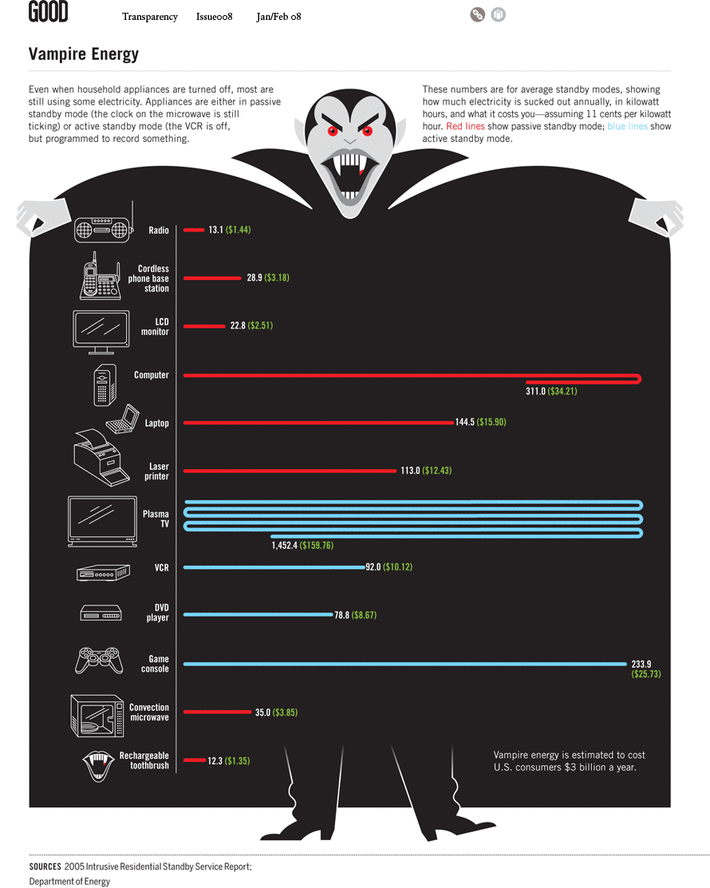 Energy Vampire Count Kilowatt Energy Vampire Count Kilowatt
There's a vampire on the loose, and he likes to leave the lights on like Motel 6. Whether you're at work, at home or out on the town, this vampire is taking a bite out of your wallet and harming the environment. But, there's no need to barricade the house and stock up on garlic just yet. This vampire works entirely though your electrical outlets and stopping this monster can be as easy as pulling a few plugs. Vampire energy is estimated to cost U.S. Consumers around 3 billion a year.
The villain in question is vampire power, also known as standby power and phantom load, from what is called a vampire device. You can also find it referred to as vampire energy, leaking energy, wall warts, standby loss, idle current, phantom power, ghost load, ghost charge, and vampire load. The terms refers to the electricity many gadgets and appliances waste just by being plugged in (even if they're switched off). After all, what do you think your cell-phone charger does all day while it's plugged into the wall? If it's warm when you get home from work, then it's been using electricity -- even if it had nothing to charge. Individually, your rechargeable electric toothbrush may not put that much strain on the local power plant, but the big picture is far more troubling. In the United States alone, vampire power costs consumers more than $3 billion a year [source: Energy Information Administration]. Over time, many microwaves and televisions actually consume more electricity during the hours they're not in use than the times you're actually using them to heat up dinner and watch your favorite show. How do you fight off the ravages of vampire power? In this article, you'll learn why this energy loss happens and how to slay it once and for all.  Vampire Energy Chart - GoodMagazine.com Vampire Energy Chart - GoodMagazine.com
I've been curious recently about how much electricity all our devices that stay plugged in all the time and in some sort of standby mode consume, even when we are not actually using them. And what does that translate into in terms of real money?
Coincidentally, GOOD Magazine has created this handy chart that graphically depicts the impact. The real surprise on it is plasma TVs--who knew they were sucking so much energy when "off"? And that game console of yours? It's costing you $25 a year just sitting there, even when you're not using it. Have more than one console? Well, do the math... The chart does not include all the wall-warts for cell phones, laptops, cameras, and the like that tend to stay plugged into the wall (and consuming some amount of electricity) even when not actually charging their devices. By some estimates these are responsible for 4 percent of all U.S. electricity consumption, equivalent to almost 100 million tons of oil. Hmm, no wonder the U.S. is 5 percent of the world's population but consumes 23 percent of its energy... Vampire Power Causes In the average U.S. home, 25 percent of electricity use by home electronics occurs while the products are off [source: Pogue]. Is this power used for anything? Do electronics manufacturers hate the environment? Vampire power causes usually include one of the following:
All this energy use enacts quite a hefty toll on the environment. Coal-burning power plants produce carbon dioxide, a leading cause of global climate change. Therefore, less vampire power translates to lower carbon emissions. Even plants that run on nuclear or hydroelectric power produce emissions that can lead to smog and acid rain. Want to know how to help the environment and save a little money on your power bill in the process? Pick up a few vampire-fighting tactics and a few online resources below!  FACT: You spend about $159 a year on standby power alone. FACT: You spend about $159 a year on standby power alone.
Fight Vampire Power
Ready to pick up your stake, take a stab at saving electricity and fight vampire power? Lucky for you, the battle against this energy waster comes down to two tactics:
A certain amount of standby power is unavoidable, especially with major appliances or other devices that are impractical to turn off. But this doesn't mean vampire power can't be kept to a minimum. Many electronic devices waste power in standby mode due to poor design. Purchase energy-efficient products and you'll waste less electricity on standby functions. The governments of the United States, Canada, Japan, New Zealand, Taiwan and the European Union all regulate energy-saving products and label them as Energy Star-certified products. These products are guaranteed to meet certain low-energy consumption criteria. Electronic devices may cause vampire power, but there are also a number of gadgets on the market designed to help cut down on unnecessary power loss. The Kill A Watt digital wattage reader from P3 International allows you to check how much power your electronic devices are consuming. Other products take the energy-saving potential of surge protectors to the next level. Watt Stopper/Legrand's Isolé plug load controller basically combines a typical surge protector with a motion detector. The surge protector consists of six occupancy-controlled outlets that power off when there's no motion in the room for a set amount of time (programmable between 30 seconds and 30 minutes). Two uncontrolled outlets still remain on. All you have to do is plug vampire electronics or lights into the occupancy-controlled outlets and plug items you don't want randomly shutting off into the uncontrolled outlets. Other power strips (such as the Smart Strip Power Strip or the Power-Saving Essential SurgeArrest 7) feature a master-slave arrangement, similar to the set up of many electronic devices. If you aren't using your computer, why have power traveling to your speakers, printer and other accessories? The smart strip lets you designate one device as the "master" and several secondary devices as "slaves". If the master device is off or drawing only standby power, then the slave outlets don't get any power either. All these weapons may seem useless against the billions of dollars worth of vampire power that flows through power lines each year. But if enough people become aware of the problem and take steps to prevent it, a vast amount of power and natural resources can be better used. Shown below is a list of typical household appliances along with the annual cost you could be wasting by leaving them plugged in when they are not in use (the list was created by The Conscious Consumer along with the Lawrence Berkeley National Laboratory and the American Council of Energy-Efficient Economy, and it assumes electricity cost of 11 cents/kwh): Digital cable box with DVR $43.01 DVR $36.63 Set-top satellite box with DVR $27.52 Digital cable box $17.65 Satellite cable box $15.50 Laptop computer $8.81 Multifunction printer, scanner, copier $5.21 CD player $4.99 VCR $4.38 Desktop computer $3.96 Power tool $3.96 Microwave oven $3.05 LCD TV $2.97 Plasma TV $2.97 Handheld vacuum $2.97 Answering machine $1.99 Printer $1.98 Computer speakers $1.98 Answering machine $1.99 Printer $1.98 Computer speakers $1.98 Cordless phone $1.98 Electric toothbrush $1.98 Portable stereo $1.64 DVD $1.53 LCD monitor $1.12 Coffee maker $1.12 AM/FM tuner $1.11 CRT TV $1.00 Video game console $1.00 Cell phone charger (unattached to phone) $0.26 If you add up the items that are found in a typical home (one for each category) you will find that you may be very well paying nearly $100 per year in wasted standby electricity. With the information above and the links below, you should be better equipped to take on any and all Vampire Devices that may be lurking in your home. More Great Links
Sources
0 Comments
Your comment will be posted after it is approved.
Leave a Reply. |
News Watch
Mind-opening news articles, editorials, videos & apparel that inspire our readers and help liberate them from the status quo. Stay informed.
Write For UsSpace WatchTop NewsNews Watch Categories
All
|
|
|
HAVE A TIP OR STORY TO TELL? JOIN TODAY & SHARE YOUR STORY!
If you have a breaking news tip or idea, please email: [email protected] Apparently Apparel® is a registered trade name and part of the ZOAT International® brands network. © 2007-2023. All Rights Reserved. Privacy Policy. All art & news content posted on this site is commentary or opinion and is protected under Free Speech. ApparentlyApparel.com is not responsible for content written by contributing artists, authors or news feeds. The information on this site is provided for educational and entertainment purposes only. It is not intended as a substitute for professional advice of any kind. ApparentlyApparel.com assumes no responsibility for the use or misuse of this material.
|
|






